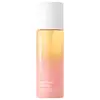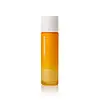What's inside
What's inside
 Key Ingredients
Key Ingredients

 Benefits
Benefits

 Concerns
Concerns

 Ingredients Side-by-side
Ingredients Side-by-side

Water
Skin ConditioningButylene Glycol
HumectantGlycerin
HumectantPrunus Persica Fruit Water
MaskingRubus Chamaemorus Fruit Juice
Skin ConditioningPolysorbate 20
Emulsifying3-O-Ethyl Ascorbic Acid
Skin ConditioningPrunus Persica Fruit Extract
AbrasiveLactobacillus Ferment
Skin ConditioningLeuconostoc/Radish Root Ferment Filtrate
AntimicrobialLactobacillus
Skin ConditioningPolycitronellol
Sodium Citrate
BufferingPhenoxyethanol
PreservativeCitric Acid
BufferingPotassium Sorbate
PreservativeParfum
MaskingLimonene
PerfumingWater, Butylene Glycol, Glycerin, Prunus Persica Fruit Water, Rubus Chamaemorus Fruit Juice, Polysorbate 20, 3-O-Ethyl Ascorbic Acid, Prunus Persica Fruit Extract, Lactobacillus Ferment, Leuconostoc/Radish Root Ferment Filtrate, Lactobacillus, Polycitronellol, Sodium Citrate, Phenoxyethanol, Citric Acid, Potassium Sorbate, Parfum, Limonene
Water
Skin ConditioningLactobacillus Ferment
Skin Conditioning3-O-Ethyl Ascorbic Acid
Skin ConditioningNiacinamide
SmoothingHyaluronic Acid
HumectantSodium Hyaluronate
HumectantPanthenol
Skin ConditioningSodium Polyglutamate
HumectantTocopherol
AntioxidantGlycerin
HumectantCitrus Aurantium Dulcis Peel Extract
Emulsion StabilisingCitrus Aurantium Dulcis Callus Culture Extract
Skin ConditioningCitrus Sinensis Fruit Extract
AntioxidantCitrus Aurantium Dulcis Fruit Extract
MaskingCitrus Aurantium Dulcis Oil
MaskingHippophae Rhamnoides Extract
MaskingLycium Barbarum Fruit Extract
AstringentRosa Canina Fruit Extract
AstringentCitrus Limon Fruit Extract
MaskingGluconolactone
Skin ConditioningLithothamnion Calcareum Extract
Skin ConditioningHelianthus Annuus Seed Oil
EmollientChondrus Crispus Extract
Skin ConditioningLeuconostoc/Radish Root Ferment Filtrate
AntimicrobialCitric Acid
BufferingSodium Riboflavin Phosphate
Skin ConditioningSodium Tocopheryl Phosphate
AntioxidantSodium Citrate
BufferingPotassium Hydroxide
BufferingXanthan Gum
EmulsifyingSodium Benzoate
MaskingCalcium Gluconate
HumectantTriethylhexanoin
MaskingPolyglyceryl-3 Laurate
EmulsifyingAcrylates/C10-30 Alkyl Acrylate Crosspolymer
Emulsion StabilisingPentaerythrityl Tetra-Di-T-Butyl Hydroxyhydrocinnamate
AntioxidantPhenoxyethanol
PreservativeChlorphenesin
AntimicrobialTriethyl Citrate
MaskingLimonene
PerfumingLinalool
PerfumingCitral
PerfumingWater, Lactobacillus Ferment, 3-O-Ethyl Ascorbic Acid, Niacinamide, Hyaluronic Acid, Sodium Hyaluronate, Panthenol, Sodium Polyglutamate, Tocopherol, Glycerin, Citrus Aurantium Dulcis Peel Extract, Citrus Aurantium Dulcis Callus Culture Extract, Citrus Sinensis Fruit Extract, Citrus Aurantium Dulcis Fruit Extract, Citrus Aurantium Dulcis Oil, Hippophae Rhamnoides Extract, Lycium Barbarum Fruit Extract, Rosa Canina Fruit Extract, Citrus Limon Fruit Extract, Gluconolactone, Lithothamnion Calcareum Extract, Helianthus Annuus Seed Oil, Chondrus Crispus Extract, Leuconostoc/Radish Root Ferment Filtrate, Citric Acid, Sodium Riboflavin Phosphate, Sodium Tocopheryl Phosphate, Sodium Citrate, Potassium Hydroxide, Xanthan Gum, Sodium Benzoate, Calcium Gluconate, Triethylhexanoin, Polyglyceryl-3 Laurate, Acrylates/C10-30 Alkyl Acrylate Crosspolymer, Pentaerythrityl Tetra-Di-T-Butyl Hydroxyhydrocinnamate, Phenoxyethanol, Chlorphenesin, Triethyl Citrate, Limonene, Linalool, Citral
 Reviews
Reviews

Ingredients Explained
These ingredients are found in both products.
Ingredients higher up in an ingredient list are typically present in a larger amount.
You might know this ingredient as Ethyl Ascorbic Acid, a more stable version of ascorbic acid.
Like other types of vitamin C, this ingredient has many benefits including reducing wrinkles, skin soothing, dark spot fading, and fighting against free radicals.
3-O-Ethyl Ascorbic Acid interferes with the process of skin darkening, helping to reduce hyperpigmentation. It also encourages the skin to produce more collagen.
Once applied, 3-O-Ethyl Ascorbic Acid is converted to Vitamin C deeper in the skin's layers. This process is slow but makes this ingredient more tolerable for skin.
The optimum pH range for this ingredient is 4 - 5.5
Learn more about 3-O-Ethyl Ascorbic AcidCitric Acid is an alpha hydroxy acid (AHA) naturally found in citrus fruits like oranges, lemons, and limes.
Like other AHAs, citric acid can exfoliate skin by breaking down the bonds that hold dead skin cells together. This helps reveal smoother and brighter skin underneath.
However, this exfoliating effect only happens at high concentrations (20%) which can be hard to find in cosmetic products.
Due to this, citric acid is usually included in small amounts as a pH adjuster. This helps keep products slightly more acidic and compatible with skin's natural pH.
In skincare formulas, citric acid can:
While it can provide some skin benefits, research shows lactic acid and glycolic acid are generally more effective and less irritating exfoliants.
Most citric acid used in skincare today is made by fermenting sugars (usually from molasses). This synthetic version is identical to the natural citrus form but easier to stabilize and use in formulations.
Read more about some other popular AHA's here:
Learn more about Citric AcidGlycerin is already naturally found in your skin. It helps moisturize and protect your skin.
A study from 2016 found glycerin to be more effective as a humectant than AHAs and hyaluronic acid.
As a humectant, it helps the skin stay hydrated by pulling moisture to your skin. The low molecular weight of glycerin allows it to pull moisture into the deeper layers of your skin.
Hydrated skin improves your skin barrier; Your skin barrier helps protect against irritants and bacteria.
Glycerin has also been found to have antimicrobial and antiviral properties. Due to these properties, glycerin is often used in wound and burn treatments.
In cosmetics, glycerin is usually derived from plants such as soybean or palm. However, it can also be sourced from animals, such as tallow or animal fat.
This ingredient is organic, colorless, odorless, and non-toxic.
Glycerin is the name for this ingredient in American English. British English uses Glycerol/Glycerine.
Learn more about GlycerinLactobacillus Ferment is created by fermenting the Lactobacillus bacteria. It helps keep our skin's natural barrier and microbiome healthy.
Studies show lactobacillus ferment to be effective at repairing the skin barrier. Having a healthy skin barrier helps keep your skin healthy and hydrated. It also protects against bad bacteria.
As a probiotic/prebiotic/postbiotic, Lactobacillus ferment can help regular our natural biome. In fact, one study found a lack of diversity in our natural skin biome can trigger acne.
Learn more about Lactobacillus FermentLeuconostoc/Radish Root Ferment Filtrate is a natural preservative. It comes from fermenting radish roots with a bacteria called leuconostoc.
Leuconostoc comes from lactic acid.
This ingredient has antimicrobial properties and helps prevent the growth of bacteria in a product.
Leuconostoc is used to make the traditional Korean side-dish, kimchi. It is also used to make sourdough bread (both incredibly yummy foods).
Learn more about Leuconostoc/Radish Root Ferment FiltrateLimonene is a fragrance that adds scent and taste to a formulation.
It's found in the peel oil of citrus fruits and other plants such as lavender and eucalyptus. The scent of limonene is generally described as "sweet citrus".
Limonene acts as an antioxidant, meaning it helps neutralize free radicals.
When exposed to air, oxidized limonene may sensitize the skin. Because of this, limonene is often avoided by people with sensitive skin.
The term 'fragrance' is not regulated in many countries. In many cases, it is up to the brand to define this term. For instance, many brands choose to label themselves as "fragrance-free" because they are not using synthetic fragrances. However, their products may still contain ingredients such as essential oils that are considered a fragrance.
Learn more about LimonenePhenoxyethanol is a preservative that has germicide, antimicrobial, and aromatic properties. Studies show that phenoxyethanol can prevent microbial growth. By itself, it has a scent that is similar to that of a rose.
It's often used in formulations along with Caprylyl Glycol to preserve the shelf life of products.
Sodium Citrate is the sodium salts of citric acid. In skincare, it is used to alter pH levels and acts as a preservative.
Its main functions are to maintain the pH of a product and neutralize metal ions.
The acidity of our skin is maintained by our glands and skin biome; normal pH level of skin is slightly acidic (~4.75-5.5).
Being slightly acidic allows our skin to create an "acid mantle". This acid mantle is a thin barrier that protects our skin from bacteria and contaminants.
Learn more about Sodium CitrateWater. It's the most common cosmetic ingredient of all. You'll usually see it at the top of ingredient lists, meaning that it makes up the largest part of the product.
So why is it so popular? Water most often acts as a solvent - this means that it helps dissolve other ingredients into the formulation.
You'll also recognize water as that liquid we all need to stay alive. If you see this, drink a glass of water. Stay hydrated!
Learn more about Water